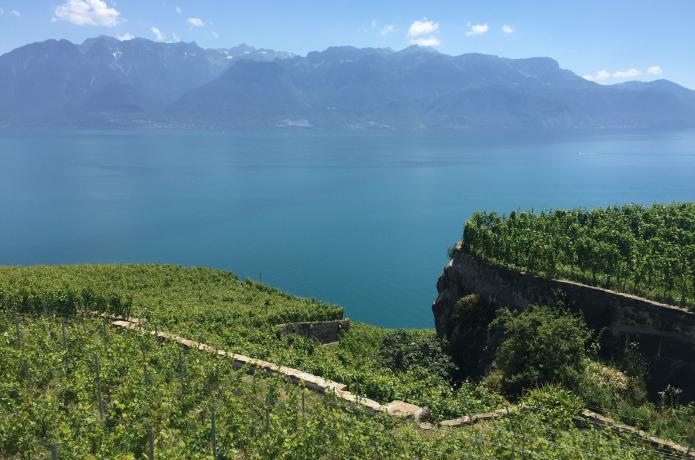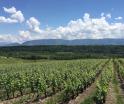19 interesting facts about Swiss wine
- Wednesday 17 May 2017
Swiss wine is one of Switzerland’s best-kept secrets, since it’s not widely known internationally as a wine-producing country. As vineyards throw open their doors to visitors in ‘open cellars’ season, The Local raises a glass to the Swiss wine industry.
1. Grapes have been grown in Switzerland since Roman times.
2. Some 148km2 of the country – or 15,000 hectares – is covered with vines, less than 0.4 percent of Switzerland’s total surface area. That sounds small, but it puts the country tenth in the world in terms of the vineyards-to-country-surface-area ratio, according to industry body Swiss Wine Promotion.
3. Switzerland produces around 100 million litres of wine (or one million hectolitres) every year, though that figure has dropped slightly in recent years due to poor harvests. As a comparison, the world’s biggest producer, Italy, made nearly 49 million hectolitres in 2016.
4. The Swiss drink nearly all the wine they make. In 2016 Swiss residents drank 89 million litres of domestic wine, which made up a third of the total 235 million litres of wine quaffed in the country (much, therefore, is imported). Only around one percent of Swiss wine is exported, mainly to Germany.
5. Vineyards cover six grape-growing regions. Valais is the largest, growing 33 percent of the total, followed by Vaud (25 percent), German-speaking Switzerland (19 percent), Geneva (10 percent), Ticino (seven percent) and the Three Lakes region, which covers Neuchâtel, Morat and Biel/Bienne (five percent).
6. Over 200 grape varieties are grown in Switzerland. The most popular are Chasselas (white) and Pinot Noir (red) which comprise 27 percent and 29 percent of the total production respectively. Other popular varieties include Gamay, Merlot, Humagne Rouge, Arvine and Savagnin Blanc, Gamaret, Garanoir, Pinot Gris.
7. Chasselas is a very old native Swiss grape variety that originated on the shores of Lake Geneva. It is still the most dominant grape of the Vaud region, where it makes up 61 percent of the total grape production. It’s also grown widely in the other Swiss wine regions including in the Valais where it is known as Fendant.
8. Like France, Switzerland classifies its wine by AOC (appellation d’origine contrôlée) which defines wines by their geographical area, characterized by particular growing conditions (terroir).
9. The Valais has the driest climate of all the Swiss wine producing regions and enjoys the warm foehn wind, which accelerates the maturation of the grapes.
10. Switzerland’s most famous wine-growing area is the Unesco World Heritage site of Lavaux in Vaud. It dates from the 12th century when Cistercian monks planted the Dézaley vineyard in terraces on the slopes next to Lake Geneva. Dézaley is known for its fine Chasselas wines and is one of only two vineyards in the region to be classed with the superior ‘Grand Cru’ label.
11. The grapes in the Lavaux are said to benefit from ‘three suns’ – the sun itself, the heat emitted by the walled terraces and the light reflected off the lake.
12. The steep gradient of the vineyards of Lavaux and many others in Vaud, Valais and Geneva means grapes must be harvested by hand rather than machine. Helicopters are sometimes used to collect large quantities of picked grapes, as are small monorail wagons that can be seen in many terraced vineyards.
13. Wine is much revered in the Vaud town of Vevey on Lake Geneva which every 20 years hosts the Fête des Vignerons, a Unesco-protected festival dating back to the 17th century which celebrates the long-held traditions of the local wine industry. The next edition is in 2019.
14. The Swiss-German winemaking region comprises vineyards in 17 German-speaking cantons and is dominated by the Pinot Noir grape which makes up nearly 60 percent of the total harvest.
15. Ticino enjoys a sunny, Mediterranean climate that is well suited to growing Merlot grapes – one of the principal grapes grown in France’s famous Bordeaux wine region – which make up 83 percent of the Ticino’s production.
16. The highest altitude vineyard in Switzerland (and indeed Europe) is the Visperterminen in the Valais, at 1,150m.
17. The vineyard of Saillon in the Valais is thought to be the smallest vineyard in the world. It’s owned by the Dalai Lama after it was bequeathed to him in 1999, and produces a few thousand bottles of wine that are sold to benefit underprivileged children.
18. If you’re a wine lover, one of the best things about early summer in Switzerland is taking part in one of the country’s open cellars days (caves ouvertes/cantine aperte/offene weinkeller). During these delightful days or weekends, buy a (generally pretty cheap) ticket which comes with a free tasting glass and head into the vineyards. Here, you’ll wander from wine cellar to wine cellar, sampling as much wine as you like. The next open cellars events are being held in Geneva (May 20th), the Valais (May 25th-27th), Ticino (May 27th-28th) and Vaud (June 3rd-4th).
19. So you’ll need to know how to say cheers. Pick from Santé/Proscht/Salute depending on your language area, and don’t forget to look the person in the eye when you clink glasses!









